Note: If an image ever fails to appear - refresh your page, it really is there
The Evolution of the Polish Coat-of-Arms - Part 2
by Chrystian Kretowicz and Peter Loeser
| Polish Coat-of-Arms Part 1 | Polish Coat-of-Arms Part 2 |
The House of Wettin was a dynasty of German counts, dukes, prince-electors and kings that once ruled the area of today's German State of Saxony. As indicated in Part 1, two of these Wettin rulers were Kings of Poland (between 1697–1763) and a third would rule the Duchy of Warsaw (1807–1814) as a satellite of Napoleon.
The Evolution of the White Eagle Chart - Part 2
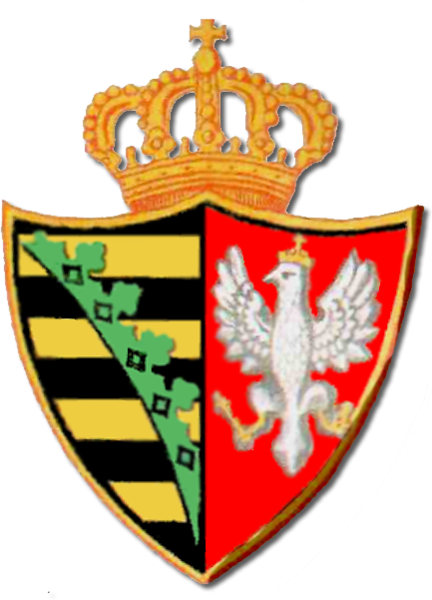 Duchy of Warsaw (1807–1813) 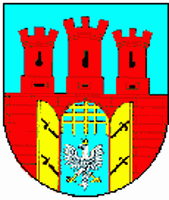 Krakow Republic (1815-1846) 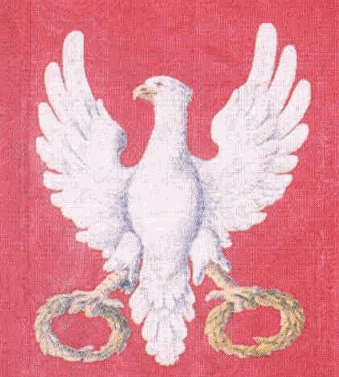 Republican Eagle (1845)  Grand Duchy (1846-1918) |
Coat-of-Arms of the Duchy of Warsaw 1807-1813
The Duchy of Warsaw was a Polish state established by Napoleon Bonaparte in 1807 from Polish lands he seized from the Kingdom of Prussia. The area of the Duchy had already been liberated by a popular uprising in 1806, provoked by proclamation of conscription to the Prussian Army. The area of the Duchy was 158,000 km with a population of over 4.3 million, so it was soon tasked with providing food for the French army (which was fighting the Russians in East Prussia) and providing additional military support for Napoleon. Since the Duchy was highly militaristic, it soon fielded a 200,000 strong army under Prince Jozef Poniatowski (a Marshal of France) and was very eager to fight the Russians. That army, eventually, covered the chaotic and disastrous French withdrawal from Russia and is credited with saving what was left of the Emperor's military forces.
Coat-of-Arms of the Free City of Krakow
(Krakow
Republic) 1815-1846
After the fall of Napoleon, according to the Congress of Vienna (1815), the territory of the Duchy was divided into three parts: Kingdom of Poland in personal union with Russia, the Grand Duchy of Poznan in real union with Prussia, and the Free City of Krakow (under protection of the three powers, but in 1846 annexed by Austria). The Krakow Republic was formally called, the "Free City of Krakow" from 1815 until 1846. When, after the failed Uprising of 1846, it was annexed by the Austrians, and its name changed to the "Grand Duchy of Krakow."
Coat-of-Arms of the Grand Duchy of Krakow
(Cracow) 1846-1918
Although the Austrians annexed Cracow after the failed Uprising of 1846, the Polish White Eagle was retained in the Coat-of-Arms of the newly created Grand Duchy of Cracow, albeit on the shield in the shape characteristic in the Austrian heraldic tradition. The eagle was displayed as the Cracow Arms on its chest. |
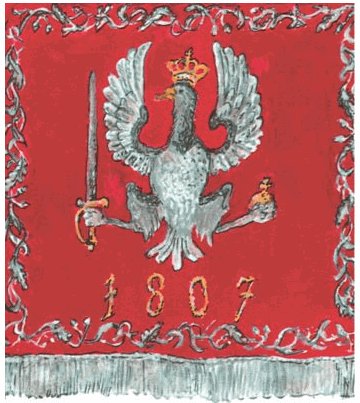 Duchy of Warsaw Banner 1809 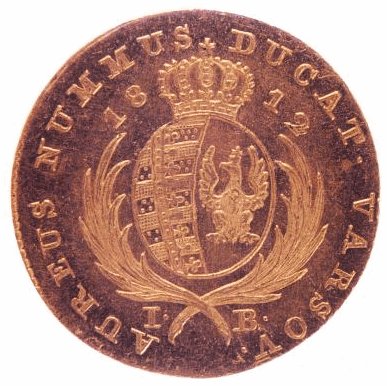 Duchy of Warsaw Ducat 1815 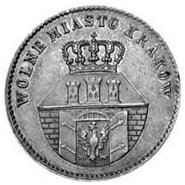 Seal of the Free City of Krakow 1815 |
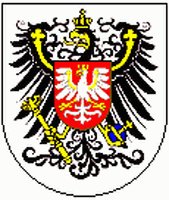 (1815-1848) |
Coat-of-Arms of the Grand Duchy of Poznan (Posen)
(Wielkie Ksiestwo Poznanskie)
The 1815 Congress of Vienna obliged Prussia to create an autonomous Grand Duchy of Poznan (Posen) out of the most of the Polish territories under their occupation. The Grand Duchy didn’t enjoy the autonomy for long, but its coat-of-arms featured the Polish White Eagle as the heart shield on the chest of the Prussian black eagle.
It also served as the crest in the Grand Arms of the Duchy. |
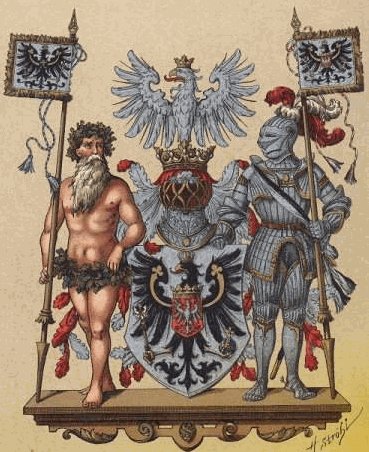 The Grand (or Greater) Arms of the Duchy |
|
The "Congress" Kingdom of Poland
(Królestwo Polskie Tsarstvo Pol’skoye)
The Kingdom of Poland (Królestwo Polskie Tsarstvo Pol’skoye) was also known as the "Congress Kingdom," because it was created by the 1815 Congress of Vienna.
The resulting Kingdom of Poland became a semi-independent state in the personal union with Russia (The Tsar of Russia was also the King of Poland). Its coat-of-arms featured the eagle similar to the ones used by the last of the Polish king Stanislaus Augustus Poniatowski and later by the Duchy of Warsaw between 1807 and 1815.
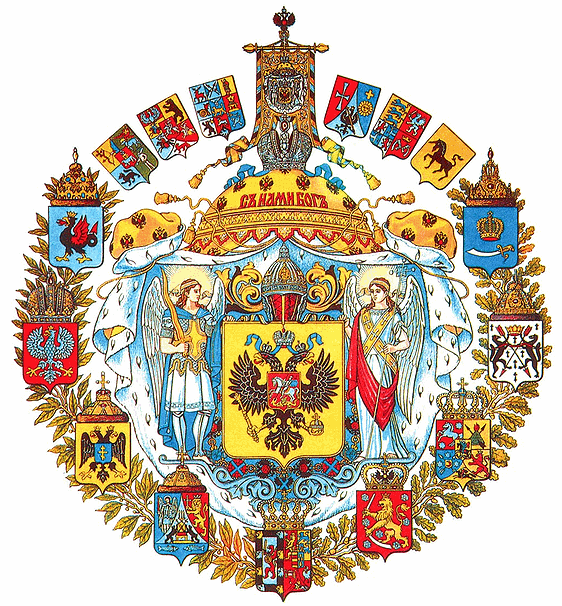 Russian Greater Seal with Polish Eagle Russian Greater Seal with Polish Eagle
The Russian official symbol of the Kingdom of Poland eventually was displayed on the chest of the double-headed black eagle of Russia. The Russian double-headed eagle with the Polish eagle on its chest was a common symbol deployed after the November Uprising of 1831. |
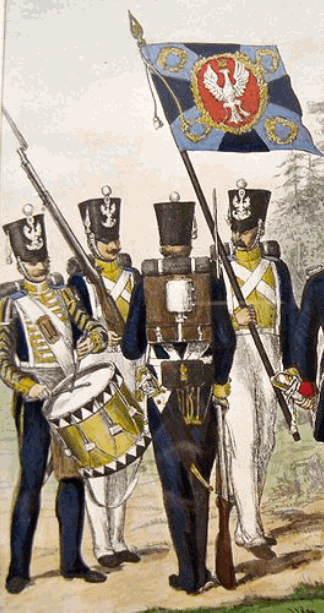 Soldiers of the Kingdom of Poland 1815 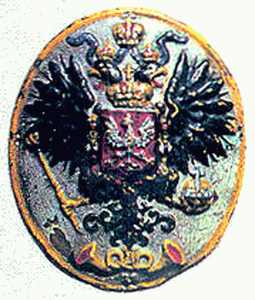 Later "Russianized" coat-of-arms 1858 |
 (1830) |
November Uprising Coat-of-Arms
The November Uprising (1830–1831), also known as the Cadet Revolution, was an armed rebellion against the rule of the Russian Empire in Poland, Lithuania, Belarus and Ukraine. The uprising began on November 29, 1830 in Warsaw when a group of young non-commissioned officer conspirators from the Imperial Russian Army's military academy in Warsaw led by Piotr Wysocki revolted. They were soon joined by large parts of Polish society.
Despite several local successes, the uprising was eventually crushed by a numerically superior Russian army under Ivan Paskevich. |
 November Uprising Coin 1831 |
 (1863-1865) |
January Uprising Coat-of-Arms
The January Uprising (Powstanie styczniowe) was an uprising in the former Polish-Lithuanian Commonwealth (present-day Poland, Lithuania, Belarus, Latvia, parts of Ukraine, western Russia) against the Russian Empire. It began January 22, 1863, and lasted until the last insurgents were captured in 1865.
January Uprising`s coat of arms, respecting 3 nations forming the Polish-Lithuanian Commonwealth: White Eagle (Poland), Vytis (Lithuania) and Archangel Michael (Ruthenia) |
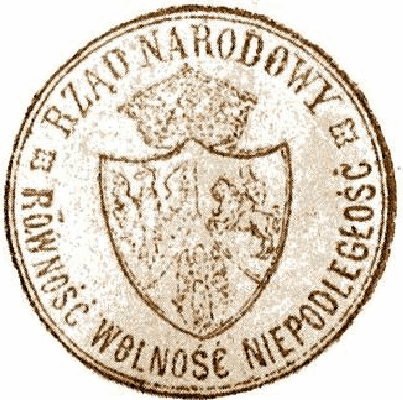 Equality, Freedom, Independence Seal 1863 |
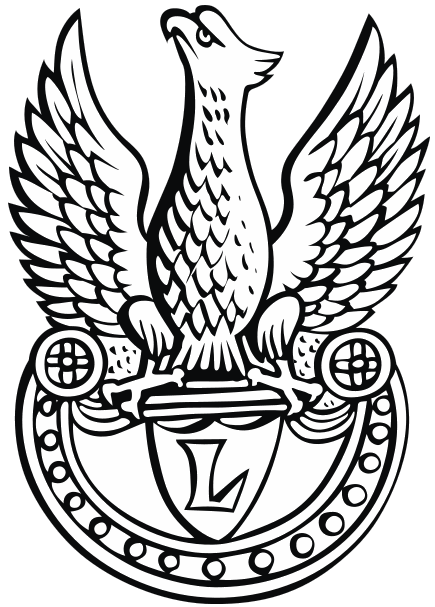 (1914-1918) |
Pilsudski’s Polish Legions
In 1914, Jozef Pilsudski persuaded the Austrian authorities to form the independent Polish military units within the structures of the Austro-Hungarian Army to jointly fight the Russians.
His theory was that the Central Powers would eventually loose the war with the Western Allies and Poland would be re-created and united out of all three parts of the partitions.
This theory proved to be absolutely right.
The eagles of Pilsudski’s Legions were bare-headed (without crowns) given his socialist leanings of the time. |
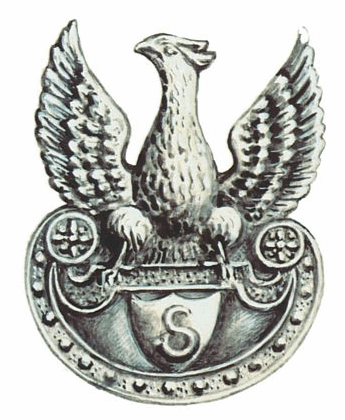 Pilsudski Military Standard |
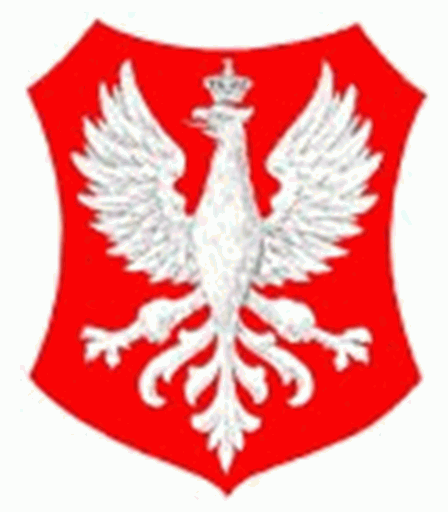 (1916-1918) |
Regency Kingdom of Poland
Królestwo Polskie
Königreich Polen
German and Austro-Hungarian Emperors, in order to secure Polish support in the war with Russia, declared ostensibly independent Polish Kingdom (known also as the Regency Kingdom), in reality, nothing more than the Central Powers’ puppet state.
Nevertheless, that kingdom was represented once again by the proud Polish White Eagle. On the right, there is a rendition of it from the banknote of the time. |
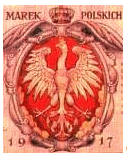 Image on Regency Banknote |
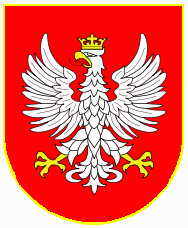 (1917-1919) |
Polish National Committee - Comité national polonais
Komitet Narodowy Polski Paris
Of diametrically different orientation than Pilsudski’s Polish Legions, a group of National-Democratic patriots chose alignment with the Allied Powers and organized the Polish Army in France (Haller’s Blue Army) to fight on the Western Front in exchange for the Allied support of Poland’s independence.
The most prominent leaders of it were Roman Dmowski and Ignacy Jan Paderewski, a virtuoso pianist, composer and close personal friend of the American president, Woodrow Wilson. The Committee, grudgingly, accepted Pilsudski’s authority when he declared Poland totally free and independent in 1918, and dissolved itself when he called upon Paderewski to form the first government of the Second Republic.
The PNC eagle was truly majestic, although displaying highly conservative and nationalistic tendencies. |
 Haller's Blue Army Poster |
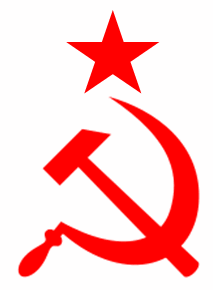 (1920) |
Aborted Polish Soviet Socialist Republic of
August
The Bolshevik Red Army reached suburbs of Warsaw in August of 1920. If they would have it their way and took the capital city, the Polish Soviet Socialist Republic would have been proclaimed.
Instead of the White Eagle, its emblem would have been the hammer and the sickle topped, most likely, by the red star.
It didn’t happen, but the Soviet propaganda poster of the era
shows clearly what they would do to the White Eagle. |
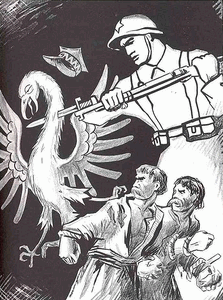 Soviet Poster |
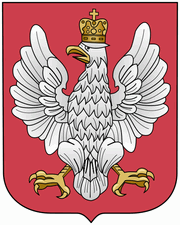 (1919-1927) |
Coat of arms of the Second Polish Republic
The Second Polish Republic, or Second Commonwealth of Poland, or simply, interwar Poland, refers to Poland between the two World Wars; from the creation of an independent Polish state in the aftermath of World War I, to the invasion of Poland in 1939 by Nazi Germany, the Soviet Union, and the Slovak Republic, which marked the beginning of World War II.
The first Arms of the Second Republic were legally adopted on August 1, 1919 by the Parliament (Sejm), although it had been in use from October 1918 (Zakopane Republic).
Those Arms were modeled on the popular eagles from the times of the last king and symbols of the Napoleonic Duchy of Warsaw.
It is unknown who was the designer of the final artistic rendition of these particular White Eagles. |
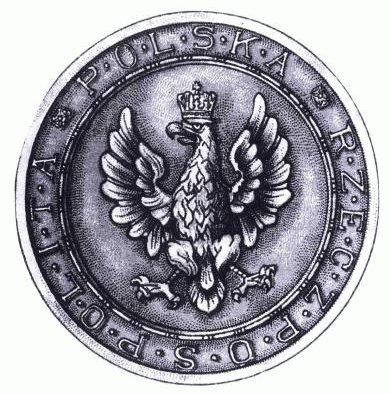 Second Republic Seal 1919 |
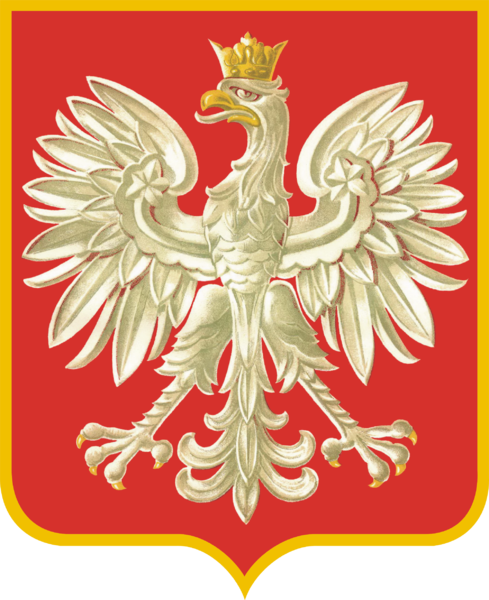 (1927-1939) |
Coat-of-Arms of the Second Polish Republic
The Coat-of-Arms of the Second Republic was changed by the decree of the President, Ignacy Moscicki, on December 13, 1927. The new, more modern rendition of the White Eagle was designed by Dr.Zygmunt Kaminski. The closed crown, topped with the cross, was replaced by the open one, without the cross, and the star-like ( or rosettes?) devices were added to the wings. There is no clear explanation on why the change happened.
This eagle represented Poland until the capitulation of last Polish Army units on October 2, 1939, but continue as the symbol of the Polish Government-in-Exile in Paris and London, of Polish Armed Forces in the West and in the USSR (1941-42) and the underground authorities and resistance forces in the occupied homeland.
In 1956, the Polish Government-in-Exile, still operating in London and recognized by several foreign states (The Vatican, Spain, Republic of China, South Africa, among others) decided to add the cross to the crown on the eagle’s head to underline the coming millenium anniversary of the Polish statehood and Christianity and to stress its opposition to the communist usurpers of power inside Poland. |
 Second Republic Coin 1930 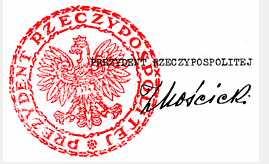 The Orzel Bialy was used on all official documents |
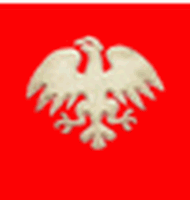 PKWN (1944) |
Polish Committee of National Liberation
July 22, 1944
The Second Polish Army was organized in the USSR under the auspices of the Communists (Union of Polish Patriots) in 1943. To break with the bourgeois tradition, the new eagle was designed for these troops. Authored by Janina Broniewska, an artist, it was modeled after the eagle adorning the sarcophagus of the medieval Piast princes in Plock and originally designed by Z.Vogl in 1825.
Piasts were promoted by the communists as the peasant and proletarian rulers of Poland, in contrast to the bourgeois and capitalist scoundrels of pre-war Poland.
That eagle appeared also on posters and flags used by the first communist-dominated government on the liberated Polish territory - PKWN (Polish Committee of National Liberation) in Lublin on July 22, 1944. Due to its ugliness, it was called "kurica" (Russian for ‘chicken) by the soldiers of the Kosciuszko Division and not gaining any popularity it was soon abandoned. |
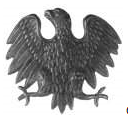 Kosciuszko Division Chicken |
 (1955-1989) |
People's Republic of Poland
The Polish People's Republic (Polska Rzeczpospolita Ludowa, PRL) was the official name of Poland from 1952 to 1990. Although Communists took the control of the country immediately after the liberation from Nazi Germany in 1944, the name of the state was changed only eight years later, reflecting the final liquidation of all democratic oppositions.
The Manifesto of the Polish Committee of National Liberation (PKWN), also known as July Manifesto, was the work of the Polish Committee of National Liberation, a Soviet-backed provisional government, which operated in opposition to the London-based Polish government in exile. Although the Polish People's Republic was a sovereign state as defined by international law, its leaders were approved by the Kremlin. They aligned their policies with those of Moscow, making the People's Republic a satellite almost entirely subordinate to the Soviet Union. Red Army forces were stationed in Poland (120,000 to 150,000). In 1945, Soviet generals and advisors formed 80% of the officer cadre of Wojsko Polskie. The Polish United Workers' Party became the dominant political party, officially making the PRL a socialist state. |
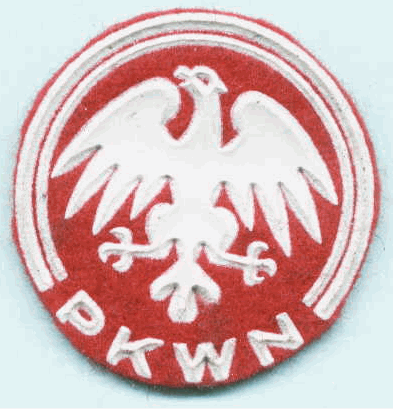 PKWN Seal 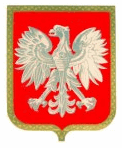 PKWN Patch |
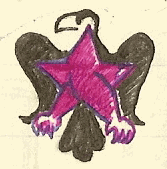 The Crow (1981-1983) |
Military Council of National Salvation
(WRON - Wojskowa Rada Ocalenia Narodowego)
In the middle of the night, on Sunday, December 13, 1981, General Wojciech Jaruzelski declared the war on his own nation, a military takeover of the state.
It was done to crush the "Solidarity" movement which was threatening the Communist monopoly on power, although the general justified it as a preventive step to stop the invasion of Poland by the Soviet, East German and Czechoslovak forces, who were deeply alarmed by the advances of the anti-communist Solidarity Movement.
The acronym chosen for the name of the new governing body - WRON, resembles the Polish word for the crow (wrona), creating an opportunity for insults and jokes directed at it. One of them was the quite poetic saying; "orla wrona nie pokona" (the crow cannot defeat the eagle). In addition, General Jaruzelski hailed from the clan of the "Slepowron," (blind crow), and wore dark glasses, to even better associate himself with the unfortunate acronym for his junta. Alas, it took a few years, but the eagle finally trashed the crow and communism with it as well. |
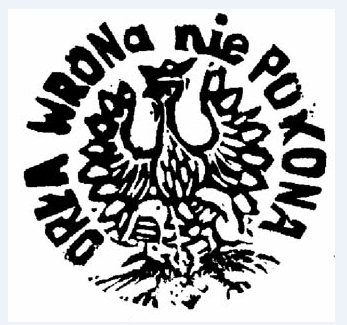 Solidarity Stamp The circular legend says
"the crow cannot defeat
the eagle"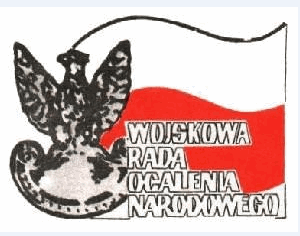 The logo of WRON |
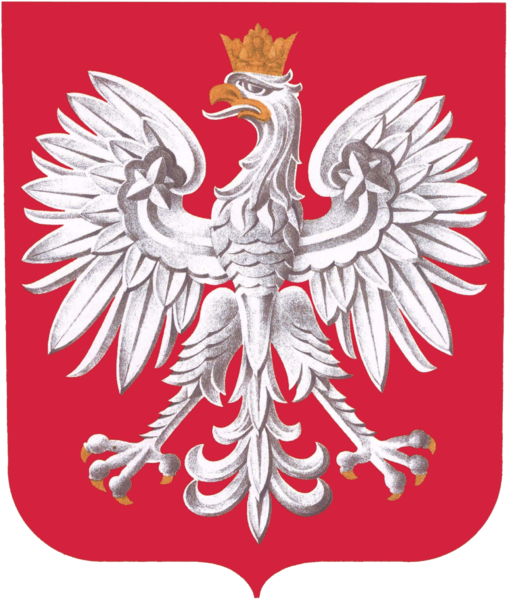 Since 1990 |
Modern Coat-of-Arms
The White Eagle (Orzel Bialy) is still the national coat of arms of Poland. Its stylized white eagle with a golden beak and talons, and wearing a golden crown, in a red shield, appears on many public administration buildings. It is present at schools and courts, on Polish coins and stamps (see images on right), and even on the Poland national football team's shirts.
According to Chapter I, Article 28, paragraph 1, of the modern Polish Constitution, the coat of arms of Poland is an image of a crowned white eagle in a red field.
The Coat of Arms Act, Article 4, further specifies that the crown, as well as the eagle's beak and talons, are golden. The eagle's wings are outstretched and its head is turned to its right. |
|
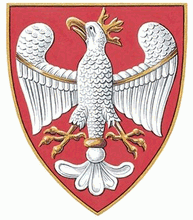 Shield on the "Jagged Sword" (Kazimierz Wielki) |
The Szczerbiec - "the Jagged Sword"
Szczerbiec (the jagged sword) is a sword that was traditionally used in the coronation ceremony of Polish kings. It is the last surviving part of the Polish crown jewels; the crown and other items were lost during numerous wars in the past.
Although, according to the legend, it was used by Boleslaw I Chrobry (Boleslaus I the Brave 992-1025), who notched it when hitting the Golden Gate of Kiev in 1018 (the Golden Gate was constructed in 1037, and there is no visible damage to the actual sword), it was probably made in the 12th century, possibly for Prince Konrad of Masovia.
Szczebiec was used during the coronations from the time of Wladyslaw Lokietek (the Elbow-High) to the last king of Poland, Stanislaus Augustus Poniatowski. After partition it was captured by Prussians, who in 1796, took it to Berlin. Later, it found itself in Russia. Finally, in 1928, the Soviets gave it back to Poland fulfilling the agreement of the Riga Peace Treaty.
During World War II it was deposited in Canada, together with the priceless arrases from the Wawel Castle in Cracow. It came back to Poland in 1959. It is currently on display in the Wawel Royal Castle Museum, Cracow.
|
 The Royal Sword "Szczerbiec" |
Polish Pride
|
The Final Comments
|
High Noon
|
| Polish Coat-of-Arms Part 1 (return to previous page) | Polish Coat-of-Arms Part 2 (top of this page) |
| Return to "Vexillological Essays and Chart Pages Menu" |
| Medieval Poland 900 to 1599 | 17th and 18th Century Poland 1600 to 1795 |
| Alliance of the Three Black Eagles (Poland Partitioned) 1795 to 1807 | Napoleonic Era and Poland 1807-1824 |
| The Congress of Vienna and its Aftermath 1820-1914 | World War I and the Parliamentary Democracy 1914 to 1926 |
| Second Republic of Poland (Sanacja) 1926 to 1939 | World War II (German and Soviet occupation) 1939 to 1945 |
| People's Polish Republic (Communist regime) 1945 to 1999 | Third Republic of Poland 1999 to present |
|